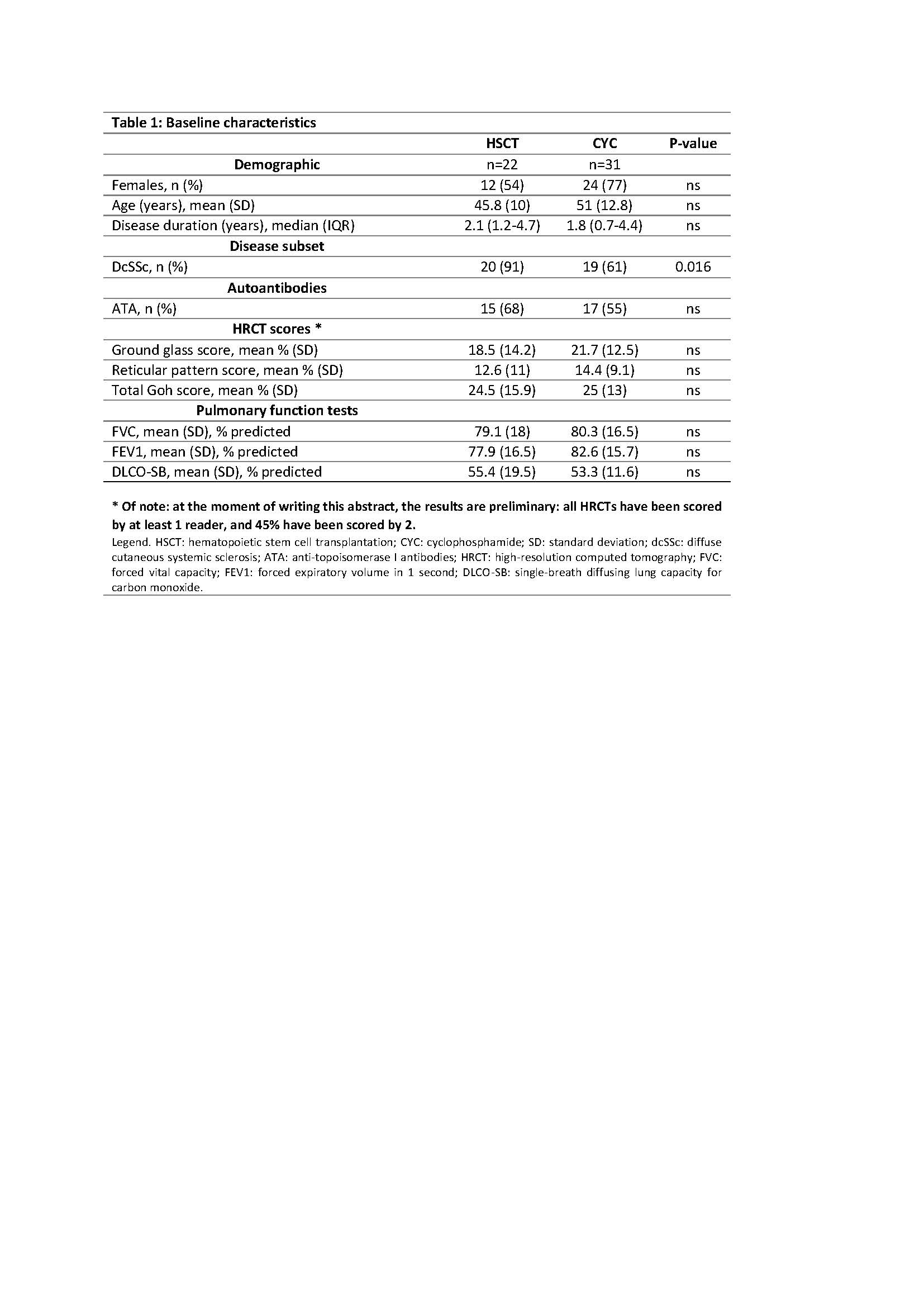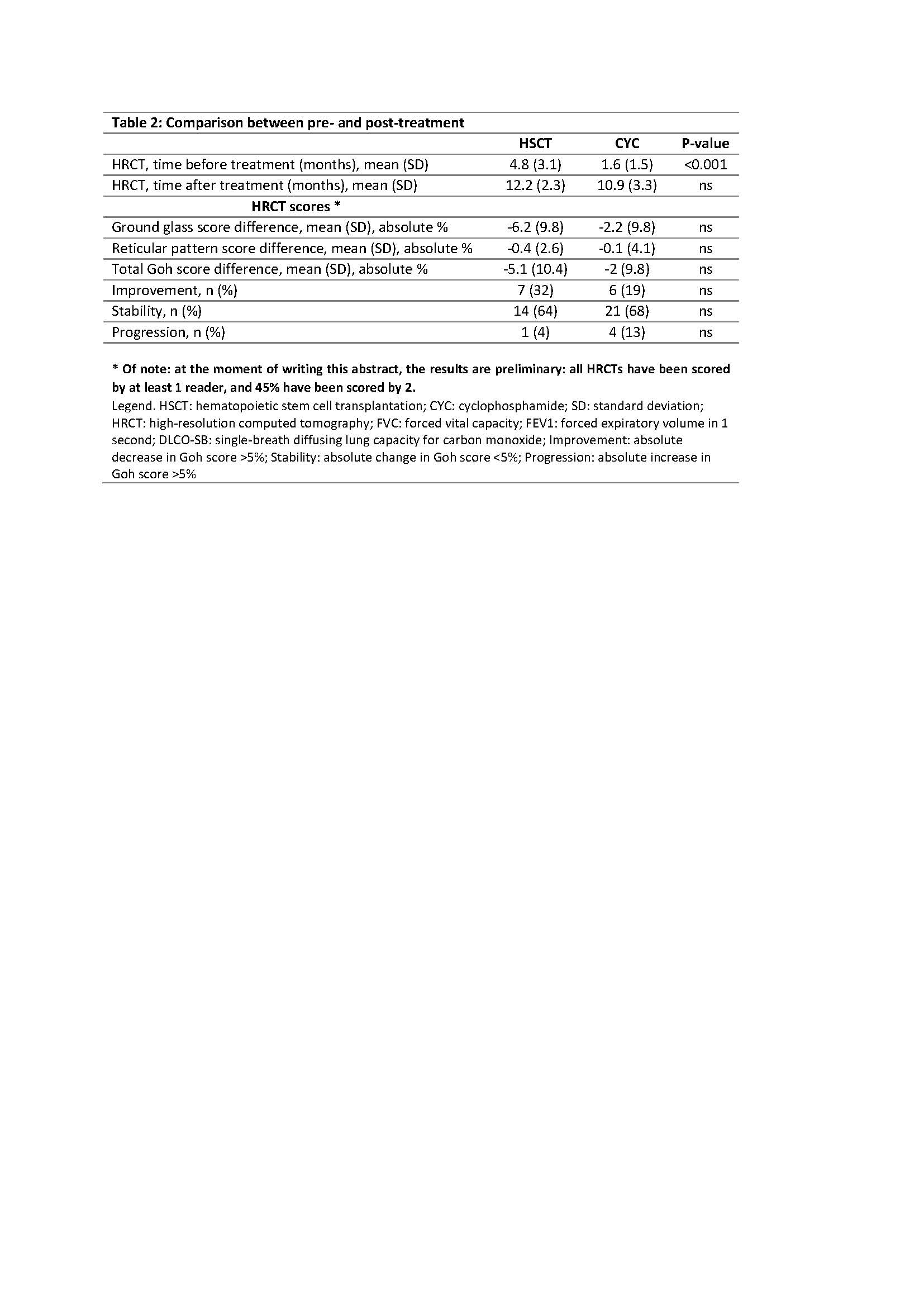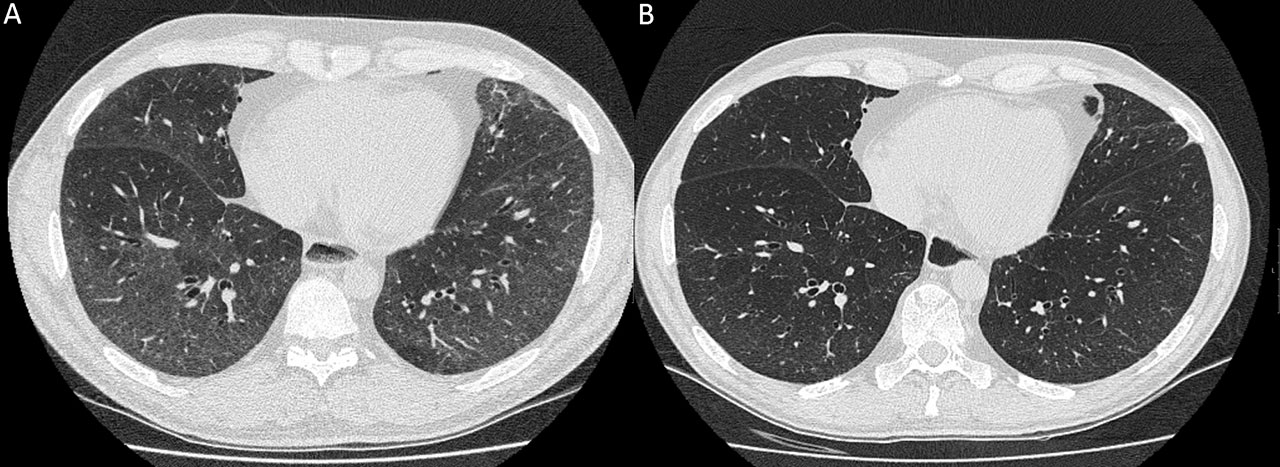Session Information
Date: Tuesday, November 12, 2019
Title: Systemic Sclerosis & Related Disorders – Clinical Poster III
Session Type: Poster Session (Tuesday)
Session Time: 9:00AM-11:00AM
Background/Purpose: Three trials demonstrated the overall superiority of autologous hematopoietic stem cell transplantation (HSCT) compared to pulsed cyclophosphamide (CYC) in SSc. An improvement in forced vital capacity (FVC) has also been described, but whether this indicates a reduction in extension of ILD has not been extensively evaluated. The main purpose of our study is to evaluate the efficacy of HSCT in inducing reduction of ILD extension assessed through high-resolution computed tomography (HRCT) in SSc patients. The secondary aims are to compare the evolution of fibrosis score after HSCT and after CYC, to evaluate how FVC changes associate with HRCT modifications, and which patients are most likely to show ILD reduction.
Methods: All SSc patients fulfilling the 2013 ACR classification criteria for SSc and treated with either HSCT or pulse CYC between 2004 and 2018 were selected. Patients with evidence of ILD at HRCT and high-quality images before and after treatment (6-18 months) available, were included. Two experienced researchers, blinded for clinical data and treatment, scored HRCTs independently and retrospectively using the “Goh score”. Discrepancies above 10% were discussed to reach consensus. Changes in mean total Goh score, and mean total scores for ground glass and reticular pattern are described. A cut-off of 5% was used to define improvement/progression. PFTs close to the HRCT time points were compared to calculate differences between pre- and post-treatment values. Regression analysis was used to study the association of relative changes in FVC and single-breath diffusing lung capacity for carbon monoxide (DLCO-SB), with change in mean total Goh score, and to study which patients are most likely to improve.
Results: Of note: at the moment of writing this abstract, the results are preliminary: all HRCTs have been scored by at least 1 reader, and 45% have been scored by 2. Thus, the reported data consist of the mean score of 2 readers in 45% of patients, and the score of 1 reader in 55%. We included 22 patients treated with HSCT and 31 with monthly CYC (Table 1). In patients treated with HSCT, mean Goh score decreased by 5.1±10.4%, which was mainly determined by a decrease in ground glass score (p= < 0.001 in linear regression). Overall, 7 HSCT patients improved (32%) (Figure 1), 14 remained stable (64%), and 1 progressed (4%) (Table2). In the CYC group, mean Goh score decreased by 2±9.8%. Six patients improved (19%), 21 remained stable (68%), and 4 progressed (13%) (all p= >0.05) (Table 2). For all patients, changes in FVC (p= < 0.001), and DLCO-SB (p= 0.018) were associated with change in mean total Goh score. In univariate analysis, patients with improvement did not differ with respect to age or disease duration but had higher total Goh score, higher ground glass score, and a trend for lower DLCO-SB at baseline.
Conclusion: HSCT resulted in reduction of ILD in 32% of SSc patients during the first year after treatment, which is mainly explained by a reduction of ground glass opacity. Changes in HRCT findings are significantly associated with changes in PFTs. In this small population, improvement/stable disease was numerically more frequent after HSCT compared to CYC, but no statistically significant difference was found.
To cite this abstract in AMA style:
Ciaffi J, van Leeuwen N, Boonstra M, Kroft L, Schouffoer A, Ninaber M, Huizinga T, de Vries-Bouwstra J. Evolution of Systemic Sclerosis-Related Interstitial Lung Disease After Autologous Hematopoietic Stem Cell Transplantation [abstract]. Arthritis Rheumatol. 2019; 71 (suppl 10). https://acrabstracts.org/abstract/evolution-of-systemic-sclerosis-related-interstitial-lung-disease-after-autologous-hematopoietic-stem-cell-transplantation/. Accessed .« Back to 2019 ACR/ARP Annual Meeting
ACR Meeting Abstracts - https://acrabstracts.org/abstract/evolution-of-systemic-sclerosis-related-interstitial-lung-disease-after-autologous-hematopoietic-stem-cell-transplantation/



